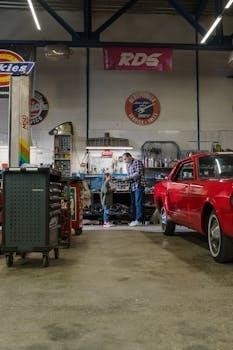The West Bend Slow Cooker is designed for convenient, hands-off cooking․ This guide provides essential information from the West Bend slow cooker instruction manual․ You’ll find everything from safety precautions to delicious recipes․ Get ready to enjoy easy and flavorful meals!

Safety Precautions
Prioritize safety when operating your West Bend slow cooker․ Always read all instructions before use, as outlined in the manual․ Unplug the slow cooker when not in use and before cleaning․ Avoid touching hot surfaces and use handles or oven mitts to prevent burns․
General Safety Guidelines
Before using your West Bend slow cooker, carefully review the general safety guidelines provided in the instruction manual․ Always ensure the slow cooker is placed on a stable, heat-resistant surface, away from flammable materials․ Never operate the appliance if the cord or plug is damaged․
Keep the slow cooker out of reach of children and pets, as external surfaces can become very hot during operation․ Use caution when removing the lid, as steam can cause burns․ Always use oven mitts or pot holders to handle the hot ceramic pot․
Do not immerse the base unit in water or any other liquid․ Avoid using the slow cooker outdoors or in damp environments․ Ensure proper ventilation around the appliance to prevent overheating․ Never leave the slow cooker unattended while it is in use․ Allow the slow cooker to cool completely before cleaning and storing․ Following these guidelines ensures safe and enjoyable use of your West Bend slow cooker․
Electrical Safety Instructions
Adhering to electrical safety instructions is crucial for the safe operation of your West Bend slow cooker․ Always plug the slow cooker into a grounded electrical outlet that matches the voltage specified on the appliance’s label․ Do not use an extension cord unless it is absolutely necessary and is rated for the appliance’s power consumption․
Never operate the slow cooker with a damaged power cord or plug․ If the cord is damaged, it must be replaced by a qualified technician to prevent electrical hazards․ Avoid overloading the electrical circuit by plugging too many appliances into the same outlet․
Always unplug the slow cooker from the outlet when it is not in use and before cleaning․ To unplug, grasp the plug, not the cord․ Do not attempt to repair the appliance yourself; refer all servicing to qualified personnel․ Keep the power cord away from hot surfaces and sharp edges․ Using the slow cooker according to these electrical safety instructions will minimize the risk of electric shock and ensure safe usage․
Initial Setup and Operation
Before using your West Bend slow cooker, carefully unpack all components․ Then, clean the cooking pot and lid․ Familiarize yourself with the basic operation instructions for safe and efficient use․
Before First Use
Prior to using your West Bend slow cooker for the very first time, it’s essential to take a few preliminary steps to ensure optimal performance and food safety; Begin by carefully unpacking all the components of the slow cooker, including the base unit, the ceramic cooking pot, and the glass lid․ Examine each part for any signs of damage that may have occurred during shipping․
Next, thoroughly wash the ceramic cooking pot and glass lid with warm, soapy water․ Rinse them well and dry completely before placing them back into the slow cooker base․ It is also advisable to wipe down the exterior of the slow cooker base with a damp cloth to remove any dust or residue․
Read the entire instruction manual provided with your West Bend slow cooker․ This manual contains important safety information, operating instructions, and helpful tips for achieving the best cooking results․ Understanding these instructions will help you avoid common mistakes and ensure a safe and enjoyable cooking experience․
Basic Operation Instructions
Operating your West Bend slow cooker is straightforward․ First, place the ceramic cooking pot securely into the base․ Add your ingredients to the pot, following your recipe․ Do not overfill the pot; leave at least one inch of space from the rim․ Place the glass lid on top of the pot․ Ensure it fits snugly․
Plug the slow cooker into a standard electrical outlet․ Select the desired heat setting․ Most West Bend slow cookers have low, high, and warm settings․ Low is for longer, slower cooking․ High is for faster cooking․ Warm is for keeping food at serving temperature after cooking․
Cooking times vary depending on the recipe and heat setting․ Always refer to your recipe for specific instructions․ Check the food periodically to ensure it is cooking properly․ Use a meat thermometer to ensure meat reaches a safe internal temperature․ Once cooking is complete, turn the slow cooker to the “Off” position and unplug it from the outlet․ Allow the slow cooker to cool completely before cleaning․

Cooking with Your West Bend Slow Cooker
Unlock culinary possibilities with your West Bend slow cooker! Discover recommended cooking times for various dishes․ Explore delicious recipes and helpful tips․ Achieve perfect, flavorful results every time you cook using your slow cooker․
Recommended Cooking Times
Achieving optimal results with your West Bend slow cooker depends on understanding recommended cooking times․ These times vary based on the type of food, its quantity, and the desired level of doneness․ For tougher cuts of meat like beef or pork roasts, longer cooking times on low heat are generally recommended to ensure tenderness․ Chicken and fish, being more delicate, require shorter cooking periods to prevent them from drying out․
Vegetable-based dishes also have specific timeframes, with root vegetables like potatoes and carrots needing more time than leafy greens․ Remember to adjust cooking times based on your specific recipe and preferences․ It’s always best to check the internal temperature of meats using a food thermometer to ensure they reach a safe and palatable level․
Refer to the West Bend slow cooker instruction manual for precise guidelines tailored to different food categories․ Factors such as the “High” or “Low” setting also influence cooking duration, so be mindful of your chosen setting․ Experimentation and careful monitoring will help you perfect your slow cooking technique․
Recipes and Tips
Unlocking the full potential of your West Bend slow cooker involves exploring various recipes and incorporating helpful tips․ The West Bend slow cooker instruction manual often includes a selection of starter recipes to get you acquainted with the appliance․ Experiment with classic dishes like pot roast, chili, and soups, adapting them to your personal tastes․
For enhanced flavor, consider browning meats before adding them to the slow cooker․ This step adds depth and richness to the final dish․ When using dried beans, pre-soaking them overnight is recommended to ensure even cooking․ Avoid lifting the lid frequently during the cooking process, as this releases heat and extends the cooking time․
To prevent food from sticking, lightly grease the slow cooker insert before adding ingredients․ Use leaner cuts of meat to minimize excess grease in the finished product․ Explore online resources and cookbooks for a wider array of slow cooker recipes, and don’t be afraid to personalize them with your favorite herbs and spices․ Remember, successful slow cooking is all about experimentation and adapting recipes to your specific needs and preferences․
Cleaning and Maintenance
Proper cleaning and maintenance are crucial for prolonging the life of your West Bend slow cooker․ Always unplug the appliance and allow it to cool completely before cleaning․ Follow these instructions to keep your slow cooker in top condition․
Cleaning Instructions
To maintain your West Bend slow cooker, always unplug it and let it cool down entirely before cleaning․ The removable ceramic cooking pot and glass lid are typically dishwasher-safe for easy cleanup․ However, hand-washing with warm, soapy water is also a suitable method․
Avoid using abrasive cleaners or scouring pads, as they can damage the surfaces of the pot and lid․ For stubborn food residue, soak the pot in warm, soapy water before attempting to clean it․ Ensure that all soap residue is thoroughly rinsed away after cleaning․
The exterior of the slow cooker base can be wiped down with a damp cloth․ Never immerse the base in water or any other liquid, as this could cause electrical shock․ After cleaning, ensure all parts are completely dry before reassembling and storing the slow cooker․ Regular cleaning will help prevent the buildup of food particles and maintain the appliance’s performance․ These cleaning steps are important to remember for the best results․ Always consult your manual for specific instructions․
Storage Recommendations
Proper storage of your West Bend slow cooker is crucial for maintaining its condition and extending its lifespan․ Before storing, ensure that all parts are thoroughly cleaned and completely dry․ This prevents the growth of mold or mildew, which can damage the appliance and affect its performance․
When storing the slow cooker, reassemble the ceramic cooking pot inside the base․ Place the glass lid on top, ensuring it fits securely․ If possible, store the slow cooker in its original packaging or a similar-sized box to protect it from dust and physical damage․
Choose a storage location that is dry and away from extreme temperatures․ Avoid storing the slow cooker in damp basements or hot attics, as these environments can damage the electrical components․
It is also advisable to store the slow cooker in a location where it will not be easily knocked over or damaged․ If you have limited storage space, consider disassembling the slow cooker and storing the parts separately․ However, make sure to keep all the components together so that they can be easily reassembled when needed․ These steps will help keep your slow cooker in good condition․

Troubleshooting
If you encounter issues with your West Bend Slow Cooker, refer to this troubleshooting section for possible solutions before contacting customer support․ First, ensure the slow cooker is properly plugged into a functioning electrical outlet․ If the unit doesn’t power on, check the outlet with another appliance to rule out electrical problems․
If the slow cooker heats unevenly, make sure the ceramic cooking pot is correctly seated within the base․ Uneven heating can also occur if the pot is overfilled or if the ingredients are not evenly distributed․ Avoid lifting the lid frequently during cooking, as this can cause heat loss and extend cooking times․
If food is cooking too quickly or too slowly, adjust the heat setting accordingly․ Remember that cooking times may vary depending on the recipe and the quantity of ingredients․ If you notice a burning smell, immediately turn off the slow cooker and unplug it․ Allow the unit to cool completely before inspecting for any food residue or damage․ If problems persist, consulting the full manual is advised․

Model Number Identification
Locating the model number of your West Bend Slow Cooker is crucial for accessing specific information, replacement parts, and warranty details․ The model number is typically found on a label affixed to the back or bottom of the appliance․ This label may also include the catalog number, which serves the same purpose for identification․
Carefully inspect the base of your slow cooker, tilting it if necessary, to locate the label․ The model number is often presented in a format like “Model No⁚ XXXX” or “Catalog No⁚ YYYY,” where XXXX and YYYY represent alphanumeric codes․ If the label is damaged or illegible, try checking the original packaging or any accompanying documentation for the model number․
Having the correct model number allows you to download the appropriate instruction manual from the West Bend website or other online resources․ This ensures you have access to accurate operating instructions, safety guidelines, and troubleshooting tips specific to your slow cooker model․ It’s always recommended to keep a record of your slow cooker’s model number for future reference․
